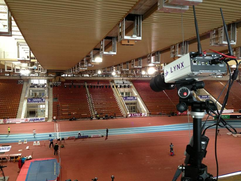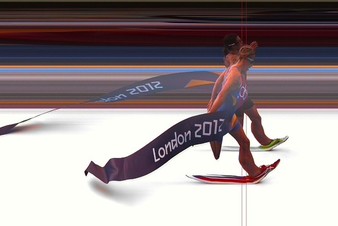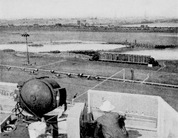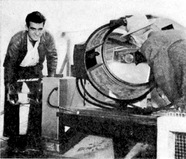How Does it Work

In track and field they use a photo finish to accurately determine the placings of racing events. Digital cameras are used for modern track and field events, historically film was used. The advantages of using Digital cameras are that they use a 1-dimensional array sensor to take 1-pixel-wide sequential images of the finish line. Since only a single line of the CCD is read out at a time, the frame rates can be very high up to 10,000 frames per second. They are be triggered by a laser or photovoltaic means.
The 2008 Summer Olympics saw the introduction of some of the fastest timekeeping equipment yet, with cameras that take photographs 3,000 times a second.
Where was the Technology Discovered
|
The use of cameras to determine placing in sport was original used in horse and dog racing in the United States. The United States motion picture cameras had been used since the 1920's for recording race meets. However these cameras were not suitable for photo-finish photography as the frame-rate was too infrequent to catch the critical instant of horses, dogs or humans reaching the finish-line. Lorenzo Del Riccio was a Paramount Pictures motion picture engineer, he improved the circular flow camera a device which had been invented in the 1930s made for the purpose of photographing moving objects. The first racing club to make use of Del Riccio's 'Photo-Chart' camera for photo-finishes was the Del Mar Turf Club in California at its inaugural meeting in 1937. Improvements were made in 1948 by Australian Bertram Pearl whose system incorporated a mirror and neon-pulse time signature in the winning-post which would provide a precisely aligned image in which both sides of the horses could be viewed, and on which the neon left a set of stripes at 100th/sec intervals for accurate timing.
|
Significance of Photo Finish
In a sport like track and field all the competitor can potentially be within 0.1 of second within each other, its almost close to impossible for the human eye to identify the accurate placings. On many occasions place getters can actually run the same time, the only way a winner can accurately be distinguished is by a photo finish. Athletics is eternally improving sport, records can be broken by only 0.001 of a second. Athletes spend their whole lives training trying to break records, a photo finish is best way to accurately get the precise time From 2005 to 2006 the 100m world record was broken 4 times, the world record progressed from 9.768 - 9.766 - 9.763 - 9.762. On average most olympic finals are won by only 0.05 of a second. The photo finish has helped improve the accurate timing of track and field and ensures a competition standard for records which helps stop controversy of inaccurate timing.
How Wide Spread is Photo finish Technology
In modern day track and field a photo finish is widely used. A photo finish is an essential component to any track and field meet. For any time to be ratified as a legal run there needs to be a photo finish. Legal runs are need to qualify for anything from the Australian Juniors to the Olympic Games. The down side to this rule is that rural runners will have to travel to compete under legal running conditions. Most meet across Australia above regional level will have a photo finish.
When is the Photo Finished Used

Photo finishes are widely used throughout modern tack and field. The main application of the photo finish is for sprinting events such as 100m, 100/110m hurdles, 200m, 400m. The 100m can last only 9.5 seconds the time difference between each of the places is so minimal. Athletes can tend to make comebacks towards the end of the race ( an example of this is the video below). Its not only the 100m that can only be separated by a photo finish. In the 2012 olympic games in London. The women's triathlon winners were so close it had to be decided by a photo finish. The event was a 1.5km swim then a 40km bike ride followed by a 10km road run. Its hard to believe that such a long event can end in a photo finish. This is the first time an Olympic triathlon result was decided on a photo finish


